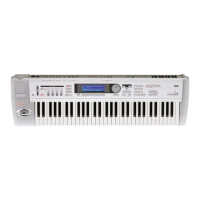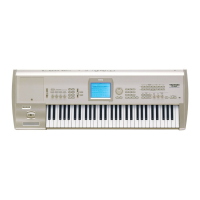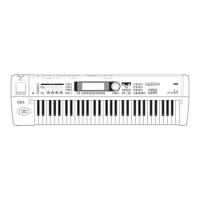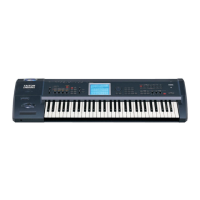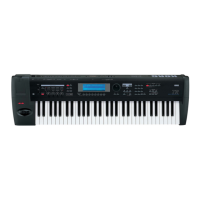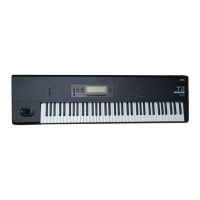10. MIDI applications
69
STEP 3
played back, the TRINITY’s sequencer will synchronize to the clock of the external sequencer,
so you will need to set the time signature and starting measures of the two sequencers to match
beforehand. Even if the MIDI Clock is set to External so that the sequencer is controlled from
outside, tracks whose Track Status is EXT or BOTH will still transmit their data.
Recording playback data from an external sequencer
There are two ways in which you can playback an external sequencer and record its playback data
on the TRINITY’s sequencer.
● Set the P1 MIDI Clock in Global mode to Internal. Begin recording on the TRINITY, and then
start playback on the external sequencer to record MIDI messages “asynchronously.”
The playback data sent via MIDI will simply be recorded just as it arrives, so the song can be
later played back correctly by the TRINITY’s sequencer, but there will be no measure divisions,
and it will be difficult to edit the data later.
● Set the P1 MIDI Clock in Global mode to External. In this method, the time at which recording
begins and the tempo etc. are determined by the external sequencer. Since recording will take
place in synchronization, measure divisions will be maintained. (However you will still need to
set the time signature before recording.) However tempo changes that occur during playback
will not be recorded, so you will have to insert tempo change data later. This method is used for
normal multitrack recording.
About GM
If a synthesizer is GM compatible, you can use any programs or voices regardless of the manufac-
turer or model. Refer to “Playback a GM Score (GM music data)” on page 74 for more information
on playing back a gm score.
About Standard MIDI Files
Standard MIDI File (SMF) is a disk data format that makes it possible to exchange sequencer play-
back data on floppy disk, regardless of the manufacturer or model of instrument that created the
data. Each song occupies one file. On the TRINITY, you can select either format 0 or format 1
when saving a Standard MIDI File in Disk mode.
● When data saved by the TRINITY in format 1 is loaded into another device, the track assign-
ments may be “skewed” from the original tracks. This is due to the fact that tracks which con-
tain no playback data are omitted, and other tracks move up to take their place. It has no effect
on the playback.
● When data saved by another device in format 1 is loaded into the TRINITY, the track assign-
ments may be “skewed” from the original tracks. This is due to the fact that tracks which con-
tain no playback data are omitted, and other tracks moved up to take their place. It has no effect
on the playback.
Sequence data that is saved in the TRINITY’s own format will contain patterns and more detailed
settings that are not included in a Standard MIDI File. When exchanging sequence data between
different instruments of the TRINITY series, it is recommended that you save sequence data in
the TRINITY series format.
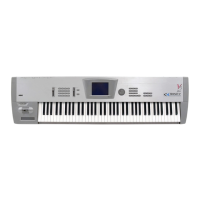
